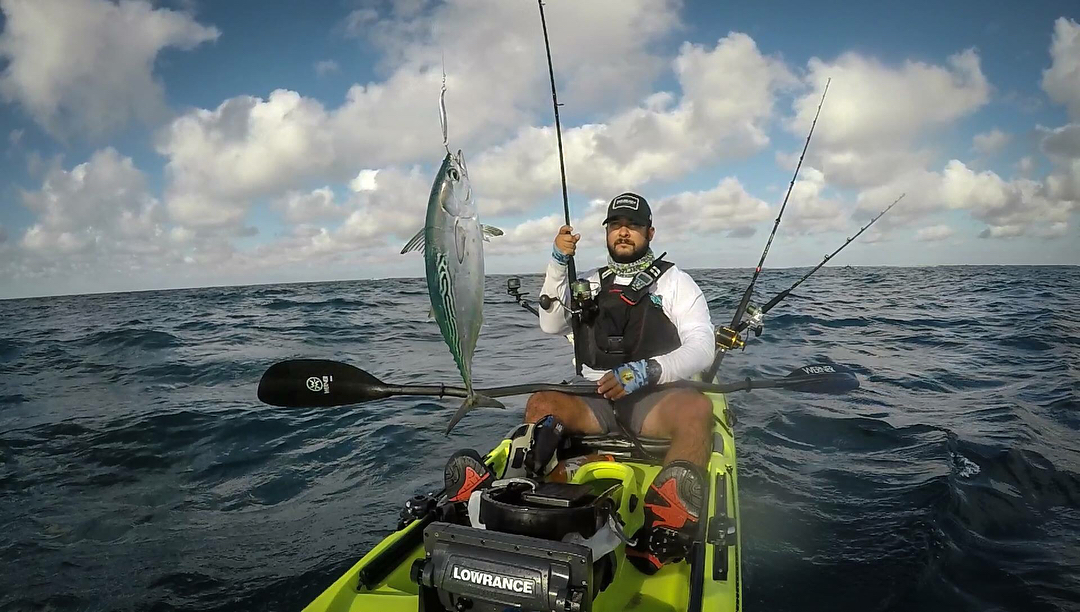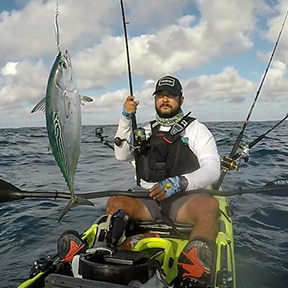Shallow Water Jigging Tips
From shallow water jigging to the other approaches out there, kayak anglers all have our favorite techniques. While the Texas coast may offer minimal range in water depth, it always brings up an interesting question. Is jigging worth it when fishing in 50 to 60 feet of water?
Who
My name is Chris Castro. I’m a YakGear Brand Ambassador and host of the Next Level Fishing (NLF) YouTube channel, where I get a chance to show people why I call our sport the next level of fishing. I’ve had the opportunity to share my trophy catches, trials, and even tragedies along the way.
What
Vertical jigging is one of those techniques that can be unorthodox for kayak anglers. It can require fast to slow pumping and rhythm, all while staying stationary. At times it can make you look like a musician while, at other times, it might make you look like you’re suffering from a hyperactivity disorder. The different presentations are among the unique traits of vertical jigging. Believe it or not, you don’t always need that aggressive pump we see so many doing. And that becomes the key to understanding shallow water jigging and its effectiveness for kayak anglers along the Texas coast.
Where
Let’s take the sparkling city by the sea, Corpus Christi, Texas. That’s where I reside. Our shallow shell doesn’t offer the ability to paddle toward 100-foot water, but the 50- to the 60-foot range is very doable. Despite water depth, where do we even begin? The answer is the structure. And, while most anglers think of ships, reefs and rock piles, Texas also offers a very different type of structure traditionally found out of range for others.
The Corpus Christi coast has several nearshore platform rigs that range between one and six miles. These rigs are where we can test jigging in relatively shallow water. We’ll often find species circling these rigs, creating a high concentration of fish.
View this post on InstagramJust another day grinding coffee. #nextlevelfishingtv #kayakfishing #filming #youtube #corpuschristi
A post shared by Next Level Fishing TV (@nextlevelfishingtv) on
When
While using fancy sonar tech will most definitely save you some time locating, it isn’t a necessity when fishing near exposed structures. My main concern on when to jig (and when not to) is mainly dependent on current. Too stiff a current and usually we’ll find some of our target species shifting off. You do have to prepare to move around. We can have beautiful, crystal-clear days that might spell a good day on the water, but sometimes the fish aren’t there. Once you find them, you’ll know. Just be sure to work close to the rigs.
How
I usually like to fuse a simple blood knot, between 50- to 60-pound fluorocarbon, to 30- to 50-pound braid. My leader’s length around here runs about eight to 10 feet, and you have several options for jigs. My personal go-to in Texas is a small Slimwave lure from Tsunami that has an attractive taper swimming action. Take the hooks off and replace them with some 4x strong Mustad hooks, and you’re good to go. Small butterfly jigs and a plethora of other styles are available, but the smaller ones here in Texas have been the ticket for me.
Once you have a jigging lure on hand, your approach is simple. (But we’ll get specific on the importance of technical details later.) If you have a paddling kayak, many will build or use a “click and go” style leash such as the YakGear ClickNGo Leash to hold position off a rig. If you are on a pedal system, one of the advantages is having the ability to control and maintain your position with your feet while you fish. Remember, we are looking for a pack of concentrating fish. Also, nearshore Texas fishing isn’t in 100 feet of water. It’s not going to be challenging to target different water columns with multicolored braid. A simple silent count when you drop can help you feel out 50 to 60 feet of water.
Let your lure drop straight down with slight thumb pressure and get a good idea of what it feels like to hit bottom. This way, you’ll know if something doesn’t feel right when a fish hits your lure halfway down. Having that slight thumb pressure is going to help ensure your senses are on point.
Retrieval is the trickiest part in jigging and, to be honest, you can have lousy form and still hook up. The important thing is to keep the focus where it belongs. Target low, mid or high areas and stay there. If you continue to lose fish jigging, I’ll share a few things later that I’ve learned to help fix that problem. Here are a few variations of retrieval to learn:
•Target Depth Twitching (low speed)
•Jerking (high speed)
•Sweeping/Trolling (low and high speed)
Those are the main techniques I use here in Texas, regardless of the type of jig. I know it may be hard to visualize by reading, so this is something I’ll work on this year on the Next Level Fishing TV show, which you can find on YouTube.
Why
All technical things aside, I jig for one reason: The rush! If you have never felt the difference between catching a kingfish trolling versus jigging, you are missing out. It’s like fighting a completely different fish, and it can have your rod bowed down to the bottom for hours if the right fish hits. For me, it’s the adrenaline side of lure fishing, and I think anyone willing to give it a go will soon agree with me.
Technical Scoop
I’m looking for a rod around 6’8” — something light and sensitive, with moderate-fast action for good recovery rate to help subdue fish quickly. Another reason you want this kind of action on your rod is to help you stay loaded during your retrieval. What this means is, you never want to have your rod tip stiff between pumps (unloaded.) Working on the form that allows you to retrieve and always remain loaded will lead to strong hooksets and increased landing ratio.
You’ll also need a good winch (reel) because you never know what will trigger a reaction strike. If you’re a fan of conventional reels, the Siegler SG makes for a great setup. If traditional is not your cup of tea, then spinning reels are an option also. I have an Okuma Cedros that’s been doing great going on three years now.
Tons of braid and fishing lines are up for grabs on the market. Just don’t forget braid quality. I’ve had the opportunity to test a few of them in the past. Strong, silky, and small-diameter braid may not sound too important when jigging, but I’ve been able to feel and see the difference in how they carry in the water. This could make the difference between being able to drop in a tight zone or not — especially in stiff current.
Chris Castro was born in Corpus Christi, Texas, but lived much of his early life overseas. As he traveled from Spain to France and on to England, fishing was always near – and the hobby developed into an early passion. He truly believes that kayak fishing is next-level fishing, and so began his journey of filming fishing adventures. In 2015, Next Level Fishing TV launched on YouTube. His passion gained notice in 2016, when yakangler.com awarded him Video of the Year. Today, Chris is president of Next Level Productions and is working with Careco Entertainment and the Pursuit Channel to produce a national television show based on kayak fishing adventures.


